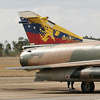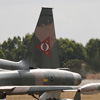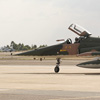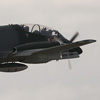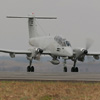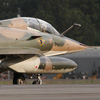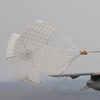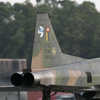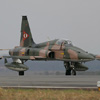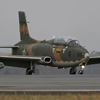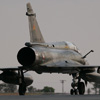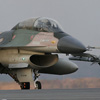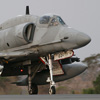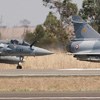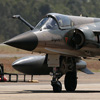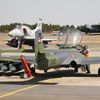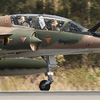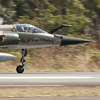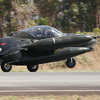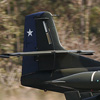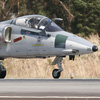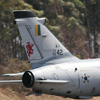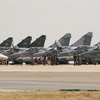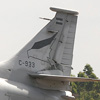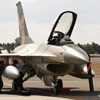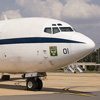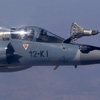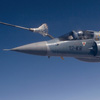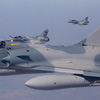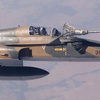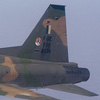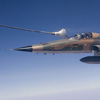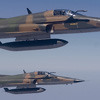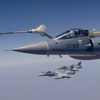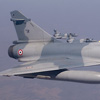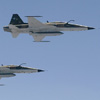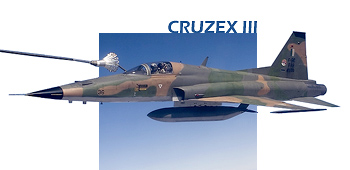
CRUZEX III 2006 Feature Report
Monday 14th August - Friday 1st September
The largest exercise of its kind in South America, the "Operação Cruzeiro do Sul", or CRUZEX, now in its third edition, is the most important combined military exercise organized by the Força Aérea Brasileira (Brazilian Air Force - FAB). This year, no less than ten air forces were invited and made the necessary preparations to take part in it, which represented quite a leap in participation compared to previous CRUZEX editions. Although the Peruvian Air Force cancelled their participation at the last moment (more about that later), the exercise was a great success according to all parties involved, solidifying the integration of their air arms, and preparing them to operate under the most modern joint structures of air power command and control.
recalls an exciting trip to central Brazil last August, where a NATO-style exercise was in full motion. All photos by the author.
Building on the experience obtained during CRUZEX I in 2002 in south Brazil (Canoas AB, to be more precise) and CRUZEX II in 2004 in Brazil's northeast (Natal AB), the Brazilian Air Force, in order to further refine and modernize its air operations' command and control (C2) standards, organized its biggest-yet military exercise ever: CRUZEX III, which took place this year from August 14 to September 1. Besides involving every major type operated by the FAB, this exercise brought to airbases in central Brazil aircraft from several other South American airforces, making Anápolis AB in particular a hotbed of magnificent new and vintage fighting machines one will be hard pressed to see anywhere else in the world.
The scenario created by the exercise reflects the preoccupation of South American countries to be able to respond to a UN Security Council call, based on the Chapter VII of the UN Charter, to intervene in order to restore peace in the region. The conflict area encompassed four different fictional countries (yellow, blue, green, and red), whose territories were all delimitated inside the borders of Brazil. After an act of aggression by State 'red', which quickly occupied part of the territory of State 'yellow', and the failure of diplomatic negotiations and UN-imposed non-military sanctions, the UN Security Council approves the formation of a Coalition Force with a Chapter VII mandate to use force, if necessary, to reestablish the recognized borders between the aforementioned countries. In that scenario, several allied South American nations, whose coalition is led by State 'blue', join forces and start an air campaign to achieve that objective.
In this coalition, six countries answered the call to provide aircraft and personnel to collaborate with Brazil: Argentina, Chile, France (due to French Guyana, an ultramarine territory situated in South America), Peru, Uruguay, and Venezuela. Three other countries, Bolivia, Colombia and Paraguay, sent observers to the exercise. Just to provide a comparison, there were only four airforces taking part in 2002 (Argentina, Brazil, Chile and France), and five in 2004 (all the ones that took part in 2002, plus Venezuela), while Peru, Uruguay and South Africa only sent observers. The increase in participation, as well as the organization of similar exercises in neighboring countries (SALITRE in Chile and CEIBO in Argentina), only reinforces the importance airforces in the region have attributed to being able to operate and deploy their air assets together.
An exercise like CRUZEX has several objectives, but clearly the main goal is to provide all involved airforces realistic training in planning joint operations with allied nations. For the FAB, it also provided its personnel additional training in operating under NATO-standard joint command and control structures, which are highly effective in managing military resources. The missions flown by the crews were mostly routine, having the pilots stressed that they weren't doing anything really out of the ordinary. Actually, the hard work was instead being performed by JFACC (Joint Forces Aerial Combined Commander) and his multi-nation staff, which was tasked with issuing mission orders, and also real-time managing the COMAO (Combined Air Operations), which involved aircraft with starkly different performances. Although the number of sorties per day never surpassed 100 (in a 10-hr. frame), it was enough to fulfill the exercise's objectives. We can't forget that the resources available to many participating airforces are limited, and will never match what NATO nations can achieve together, especially when US assets are involved. The FAB aircraft, for example, were scheduled to fly 1,925 total hours, which allowed their pilots lots of opportunities to practice their trade.
During the exercise, a total number of 671 Brazilian and 644 foreign military personnel were deployed, all under the direction of a Brazilian lieutenant-general (Ten. Brig. William Barros, the DIREX), who received advice from generals from the other participating countries, the co-directors (CO-DIREX). The scheduled number of foreign military personnel was supposed to be higher, but a most unfortunate accident reduced their number. On August 20, a Peruvian A-37B (from Grupo Aéreo n.º 7, based in northwest Peru at Piura AB) crashed while taking off from Porto Velho AB in Brazil, taking the life of its two pilots. Their loss was deeply lamented by all participants in the exercise, and naturally caused the withdrawal of the whole Peruvian contingent from CRUZEX III.
Anápolis AB in central Brazil was home to most of these personnel from August 14 to September 1, during CRUZEX's three stages: the first one was called Exercise Pegasus II, and involved a computer simulation of the activities planned for CRUZEX in the following weeks. The second one, which started on the 22nd and ended on the 25th, encompassed the familiarization flights and the force integration training for the final stage, LIVEX, which was staged from August 28 to August 31. In this last part, both air superiority and interdiction packages were flown by aircraft packages from all participating countries, supported by airborne tankers. The distribution of forces was as follows:
At Anápolis AB, the allied forces' main base, there were:
- From Argentina, three A-4ARs (belonging to the Grupo Aéreo 5 de Caza, Villa Reynolds AB) and three IA-58s (Grupo Aéreo 3 de Ataque, Reconquista AB)
- From Brazil, six F-5Es (1º GAvCa, Santa Cruz AB), six A-1s (1º/16º GAv, Santa Cruz AB and 3º/10º GAv, Santa Maria AB), three RA-1s (1º/10º GAv, Santa Maria AB), five A-29s (2º/5º GAv, Natal AB), three R-99As (2º/6º GAv, Anápolis AB), one H-34 (1º GTE, Brasília AB) and four AT-26 (1º/4º GAv, Natal AB, although this squadron also used some 1º GDA's AT-26s)
- From Chile, six A-37B (Grupo de Aviación n.º 12, Chabunco AB)
- From France, four Mirage 2000Cs (EC 02.012, Cambrai-Epinoy AB), four Mirage 2000Ns (EC 01.004, Luxeuil-St. Sauveir AB), and one E-3F (EDCA 00.036, Avord AB)
- From Uruguay, three A-37B (Esquadrón Aéreo n.º 2 (Caza), Durazno AB) and three IA-58s (Esquadrón Aéreo n.º 1 (Ataque), Durazno AB)
- From Venezuela, three F-16s (Grupo Aéreo de Caza 16, Maracay-Palo Negro AB), three Mirage 50s (Grupo Aéreo de Caza 11, Maracay-Palo Negro AB), two VF-5s (Grupo Aéreo de Caza 12, Barquisimeto AB), and a KC-707 (Grupo Aéreo de Transporte n.º 6, Maracay-Palo Negro AB)
At Campo Grande AB, which fielded the aircraft assigned to country 'red', the adversary air component, one could find six FAB F-5EM (1º/14º GAv, Canoas AB, whose recently-acquired BVR capability (due to the Rafael Derby missile) was responsible for a lot of successful engagements against allied aircraft during the exercise), five A-1s (1º/16º GAv and 3º/10º GAv), one R-99B (2º/6º GAv), one KC-130 (1º/1º GT, Galeão AB), and one H-1H (10º GAv, Campo Grande AB).
There were a few more aircraft assigned to allied forces at several places. At Brasilia AB there were two FAB KC-137s (2º/2º GT, Galeão AB), and one could find at Uberlândia and Jataí several C-SAR helicopters (two H-1H, one H-34, two H-50), together with an SC-95 Bandeirante and four AT-27 Tucanos, for a total of 90 aircraft. Of course, some other aircraft could and did fly from Anápolis during the event, the most remarkable being an C-130 which took selected media personnel for a photo hop on August 25 in which one aircraft from every single country was flown in formation behind the Hercules. But the best was yet to come.
I was fortunate enough to be able to take part in a REVO (air-to-air refueling) mission aboard one of the two KC-137s, FAB2401, that were based at Brasília AB during the LIVEX stage of the exercise. Under the able command of Capt. (now Major) Ortiz, from the 2º/2º GT, the Corsair Squadron, we took off at 1218 GMT for a three and a half hour mission, with the callsign 'Corsário 41'. After one hour of flight at FL 240, the first formation was in sight: four Mirage 2000Cs of EC 02.012, the 'Picardie' squadron. These aircraft, callsign 'Pastis 11-12-13-14', arrived in formation on our right wing, breaking formation so that the first pair could refuel, one Mirage on each wing boom. After all four had finished taking gas, they joined formation again on our left wing and departed, each one taking 3.500lbs of fuel. One of the most interesting things I was able to notice is that a good part of the refueling is made while the KC-137 is performing a left-hand turn to complete its orbit, which made for some sensational shooting with the aircraft being refueled against the darkest part of the sky.
The second formation scheduled to 'visit' us arrived soon thereafter: a pair of FAB F-5Es, callsign 'Jambock 01-02'. Again, the same pattern was followed: arrival on the right wing, a split so each aircraft could refuel together, using both booms and departure after joining formation on our left wing. These Tigers were supposed to take 2000lbs each, but they asked for more fuel (3200lbs and 2800lbs, respectively), especially because Jambock 01 had some fuel being ejected from its vent.
After all that movement, a quieter part of our flight followed, since we had nothing on the schedule for the next one and a half hours. Still in our flight box, we welcomed back Jambock 01-02, who took 2000lbs of gas each this time, and Pastis 11-12-13-14, who also received 2000lbs of fuel per aircraft. Our mission complete, we returned to base, arriving there at 1540 GMT. Although our KC-137 is quite a veteran, it performed flawlessly, taking off with 126.000lbs of gas, and providing 32.000lbs of fuel without a hitch. What an interesting flight that was to say the least!
There was some talk that there won't be a CRUZEX IV in 2008, although the exercise's pattern, until now, calls for a biannual event. Whatever happens, there is no denying CRUZEX III was a professionally-organized exercise, and a superb building block to further the cooperation and integration of South American airforces. No one wants a conflict in the region, but rest assured that, if one breaks out and the call is made, the region's air forces will be able and ready to provide the necessary means to achieve peace again.

